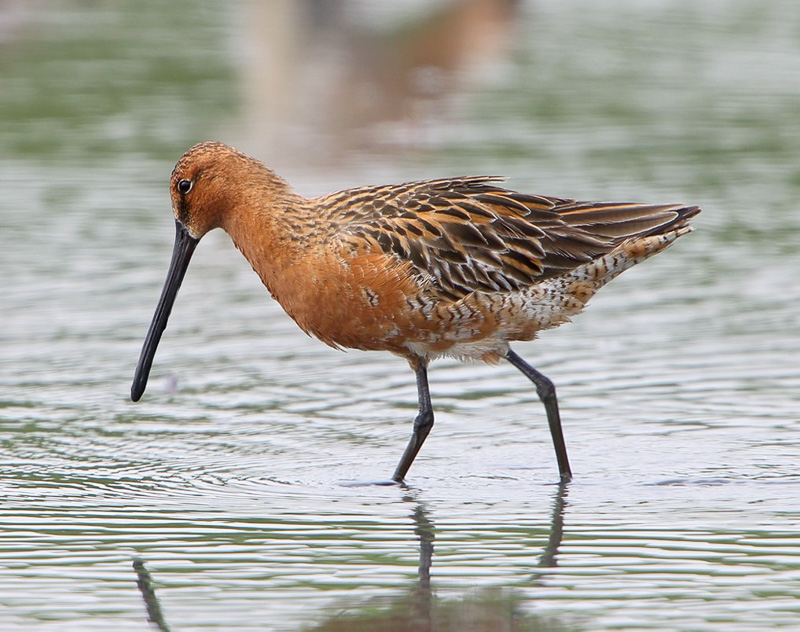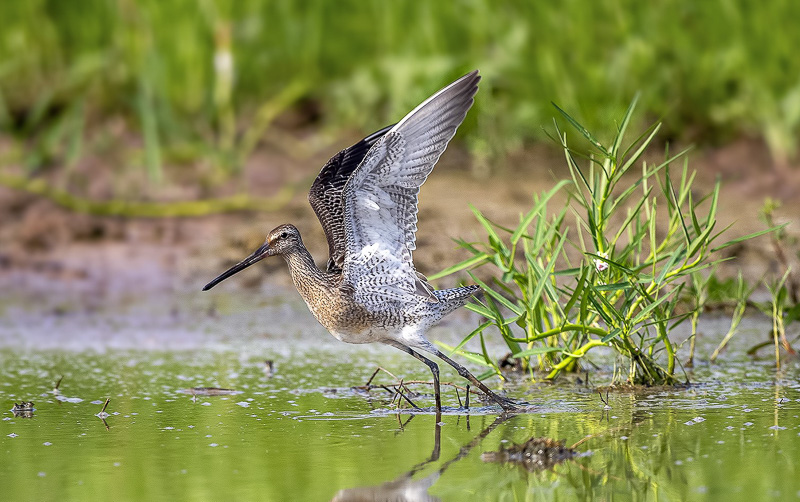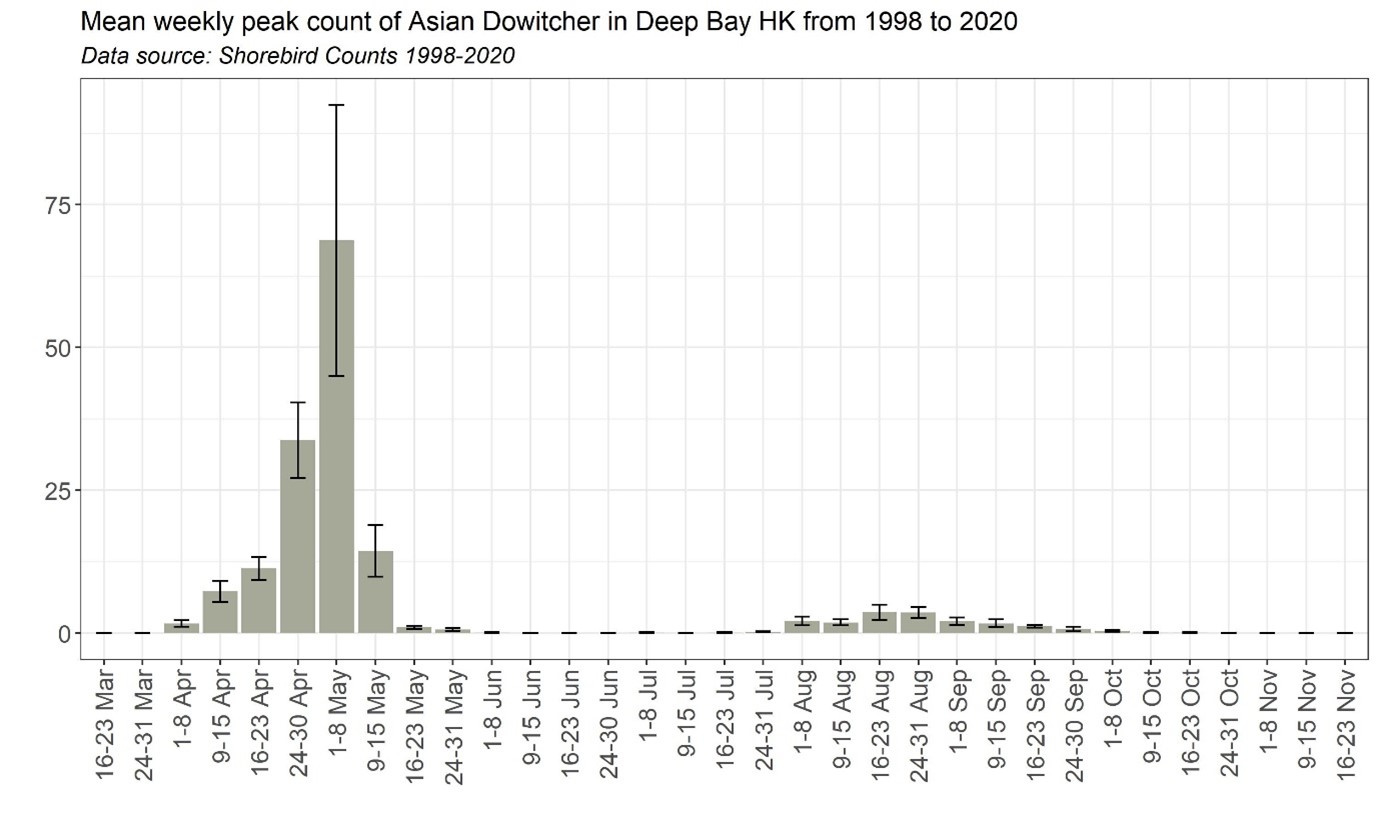ASIAN DOWITCHER Limnodromus semipalmatus 半蹼鷸
Category I. Passage migrant through Deep Bay area, common in spring and scarce in autumn.
IDENTIFICATION

May 2014, Michelle and Peter Wong. Breeding plumage.
33-36 cm. A large dowitcher slightly smaller than Bar-tailed Godwit with dark bill and legs and whitish underwings.
In breeding plumage has orange-rust head and underparts to the belly, dark lores, darkly streaked crown, grey-brown mantle, scapulars and wing coverts with a varying degree of orange-brown edges.

Aug. 2020, Godwin Chan. Juvenile.
In non-breeding plumage rather dull grey-brown overall with dark lores and crown and heavily-streaked face, neck and chest. The juvenile (illustrated) has clear cut pale fringes to upperparts and a streaked warm buff washed chest.

Aug. 2020, Godwin Chan. Juvenile.
In flight has pale underwings but densely-barred axillaries and uppertail coverts.
VOCALISATIONS
The vocalisation typically heard in HK is a characteristic rather nasal but rich ‘kyow’ that falls in pitch.
DISTRIBUTION & HABITAT PREFERENCE
Apart from two records at Long Valley (an adult during 6-8 October 1995 and a juvenile from 7 August to 1 September 2020), all records are from the intertidal mudflats of Deep Bay or adjacent roosting areas, primarily Mai Po NR. It has only once been reported on a commercial fish pond.
OCCURRENCE
First recorded on 30 August 1967, Asian Dowitcher is primarily a spring passage migrant with only small numbers recorded in autumn (Figure 1). The earliest occurrence is on 22 March 1987 and 2012, while the main passage period occurs from the last week April to the middle of May, with peak numbers in the first week of May. In most years, the peak spring count is 200 or fewer with an average of around 150, while the highest count on record is 540 on 2 May 2003. Passage is largely complete by the end of May, with most records in June and early July likely to refer to over-summering individuals, including up to two birds from 16 June to 2 July 1989.
The earliest record considered to refer to return passage concerns two on 19 July 2008, while the latest is of one on 13 November 2000. The highest autumn count is 28 on 21 August 2005. Although there is almost complete overlap in the period of occurrence of adults and juveniles in autumn, most records are of juveniles, with 13 out of 16 birds on 10 August 1991 being the highest count.
BEHAVIOUR, FORAGING & DIET
Gregarious, flocks both large and small tending to keep together at roost.
RANGE & SYSTEMATICS
Breeds in large disjunct areas from southern Siberia and northern Kazakhstan southeast through northern Mongolia and the Lake Baikal area to northeast China and southern Ussuriland; winters coastally in southeast and northeast parts of the Indian subcontinent, southeast Asia, the Philippines, Indonesia and scattered locations in Australia (Van Gils et al. 2020). In China breeds in far east Inner Mongolia and northeast provinces and passes through much of the rest of the country (Liu and Chen 2020).
Monotypic, though separation of westerly and easterly breeding populations that have different migration routes and wintering areas may warrant subspecific status (Van Gils et al. 2020).
CONSERVATION STATUS
IUCN: NEAR-THREATENED. Population trend decreasing, probably due to habitat loss on wintering grounds.
Figure 1.

Van Gils, J., P. Wiersma, and G. M. Kirwan (2020). Asian Dowitcher (Limnodromus semipalmatus), version 1.0. In Birds of the World (J. del Hoyo, A. Elliott, J. Sargatal, D. A. Christie, and E. de Juana, Editors). Cornell Lab of Ornithology, Ithaca, NY, USA. https://doi.org/10.2173/bow.asidow1.01
Liu, Y. and Y. H. Chen (eds) (2020). The CNG Field Guide to the Birds of China (in Chinese). Hunan Science and Technology Publication House, Changsha.

